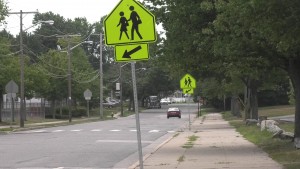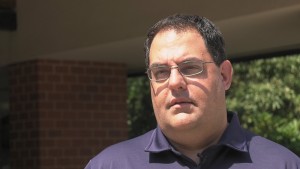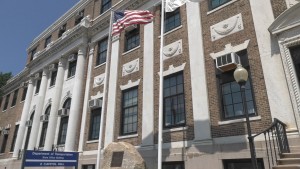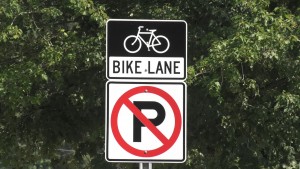 Bike racks outside an elementary school in Barrington, along with a dedicated bike lane to get there. A special crosswalk bisecting a busy road leading to another elementary school in East Providence. And a speed warning sign just before a middle school in Cranston.
Bike racks outside an elementary school in Barrington, along with a dedicated bike lane to get there. A special crosswalk bisecting a busy road leading to another elementary school in East Providence. And a speed warning sign just before a middle school in Cranston.
They are all part of the national Safe Routes to School program, funded largely by the federal government and overseen by the state of Rhode Island. It provides money for signage, sidewalks and in some cases, education.
 Jeff Pimental’s son was a student at Myron Francis Elementary school in East Providence when he helped put together an application for a Safe Routes grant in 2010. At the side entrance to the school, pedestrians, bikers and buses converged a little too closely for comfort before and after school. “It was where the school buses exited the property,” he said. “There always seemed to be a bottleneck, and a lot of kids and parents were dodging buses on the way out of the property, especially in the wintertime when the snowbanks became real high.”
Jeff Pimental’s son was a student at Myron Francis Elementary school in East Providence when he helped put together an application for a Safe Routes grant in 2010. At the side entrance to the school, pedestrians, bikers and buses converged a little too closely for comfort before and after school. “It was where the school buses exited the property,” he said. “There always seemed to be a bottleneck, and a lot of kids and parents were dodging buses on the way out of the property, especially in the wintertime when the snowbanks became real high.”
An initial round of grants had been approved in 2007, with the work completed over the next several years. In 2010, Myron Francis and nine other schools across the state got the good news that they, too, had been approved for a second round of projects totaling nearly $2 million.
 Six years later, work still has not begun at any of the schools. And it’s still a long way off. So what happened? The Hummel Report has learned the Rhode Island Department of Transportation is largely responsible for dropping the ball. And it’s one of the first things Peter Alviti got a briefing on when he took over as DOT director in early 2015. “And here we are six, seven years later and we’re at 10% completion of design when we got here,” Alviti told us.
Six years later, work still has not begun at any of the schools. And it’s still a long way off. So what happened? The Hummel Report has learned the Rhode Island Department of Transportation is largely responsible for dropping the ball. And it’s one of the first things Peter Alviti got a briefing on when he took over as DOT director in early 2015. “And here we are six, seven years later and we’re at 10% completion of design when we got here,” Alviti told us.
Unlike the first round of grants, which was completed relatively smoothly, Phase 2, Alviti said, ran into problems: Local communities worried about adhering to federal regulations that go with these projects. And some told the DOT they didn’t have the resources to do the design and engineering work.
So there were delays.
 Jeff Pimental watched and waited. “I’m just assuming [that because] it’s a federal program there’s some feet dragging, but then years go by and you’re exchanging emails with people who were helpful locally and you could tell they were in the middle of something that was out of their control. Then I just waited every year, and sent an email a follow-up and it was the same old story.”
Jeff Pimental watched and waited. “I’m just assuming [that because] it’s a federal program there’s some feet dragging, but then years go by and you’re exchanging emails with people who were helpful locally and you could tell they were in the middle of something that was out of their control. Then I just waited every year, and sent an email a follow-up and it was the same old story.”
Alviti said the good news is these projects are back on DOT’s radar screen and the funding is available. But it’s unlikely that any significant work will be done for at least another year or two.
Pimental said, “I’m glad that it is in the budget at this point and I’m glad they’re aware of our concerns and other organizations’ concerns around the state. I’m just hoping they can wrap it up; like I said, it wasn’t a major project, I don’t believe. It’s a small sidewalk on a side street and what does it take to get it done? That’s the question.”
We asked Alviti what would happen when we came back two or three years from now with the same questions, if someone had dropped the ball again and the projects were not done.
“The ball will have dropped on somebody’s head by that time if they’re not,” Alviti said. “In the time these go into construction, you’ll see the same sign that went up next to many of the projects that you see now, with those infamous red, green and yellow dots on them. Is it on time, is it on budget? And there will be a person responsible for what shows up on every one of those signs.”
Jeff Pimental put how long it has taken in perspective. “My kids will be in college almost by the time those sidewalks go in and it’s been a long challenging battle to get it done.”
The Hummel Report is a 501 3C non-profit organization that relies, in part, on your donations. If you have a story idea or want make a donation go to HummelReport.org, where you can also see the video version of this story. You can mail Jim directly at Jim@HummelReport.org.